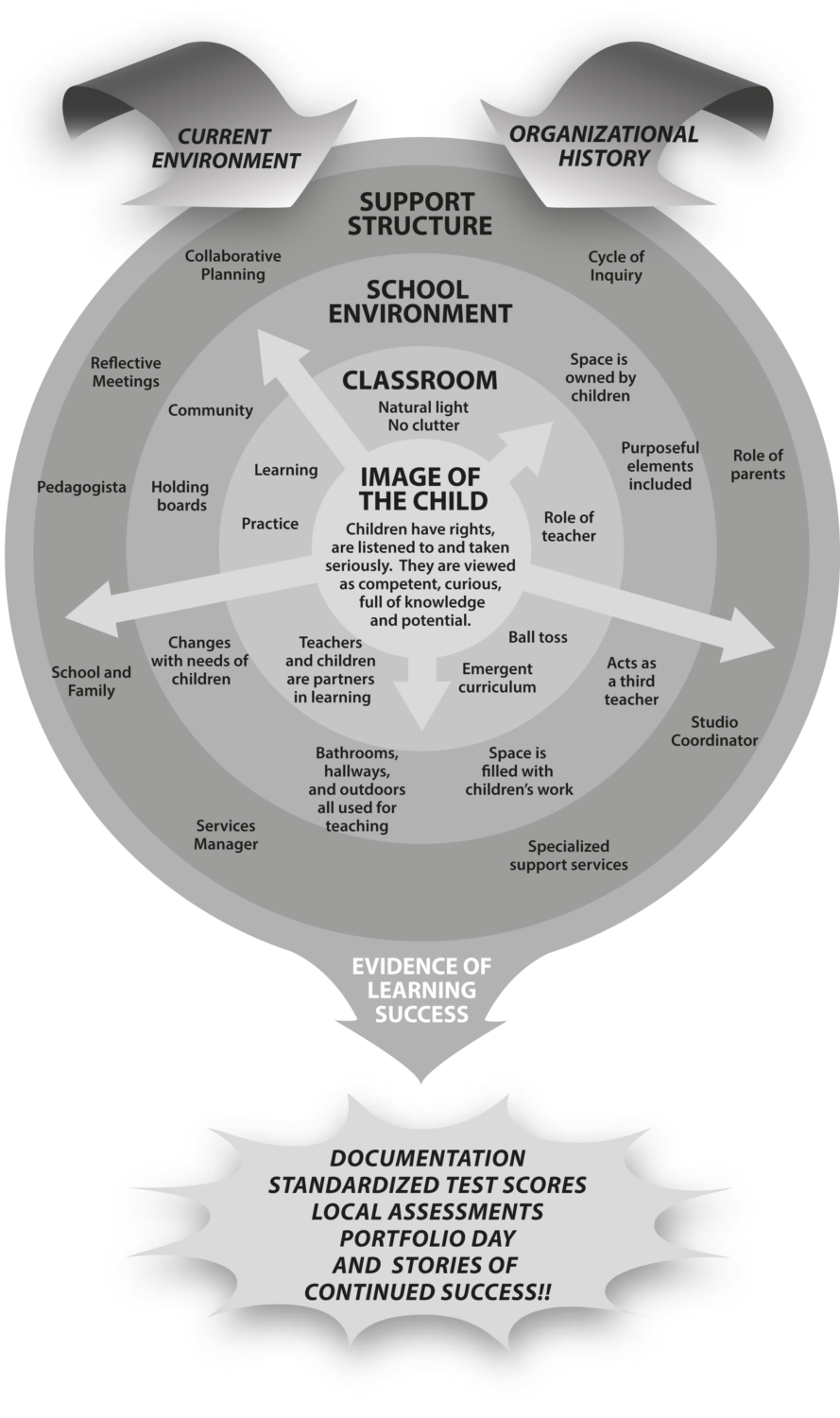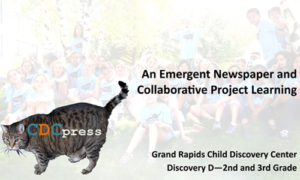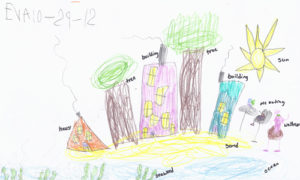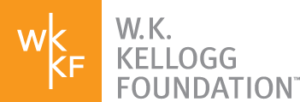Click here for the Current Educational Environment page
Click here for the Organizational History page
This term, often referred to as C.P., is the name of weekly meetings where the entire staff gathers to discuss study topics, problem solving and reflection on our teaching approach. It is planned by the principal with input from the Pedagogista. All staff members are encouraged to bring up topics to be placed on the agenda. It is facilitated by the principal. These meetings currently take place on Thursdays from 3:30-5:00 p.m.
The Cycle of Inquiry is the foundation in which teachers and children work together at the school. It is a process which combines wonder, listening, documenting and new understanding about learning among children and teachers. This process occurs frequently and informs pedagogy. The cycle begins with a framing question or a provocation (child or adult instigated), followed by observing, recording and collecting of artifacts by the teacher. Next, teachers collaboratively reflect on children’s work and analyze to arrive at new theories, inform planning and new framing questions. The cycle continues to spiral as projects emerge and learning occurs.
Space is Owned by Children
Community Engagement
The Reflective Meeting is a time to examine children’s work and learning experiences as well as teachers’ documentation. The reflective meeting team analyzes observations and artifacts in order to plan next steps, make connections to state standards and guide a study or project. This process is based on the Cycle of Inquiry and is the foundation for the creation of the emergent curriculum.
The Pedagogista elevates the Reggio Emilia philosophy within school culture. The role uses professional development, collaboration and coaching as means to support leadership, teachers and families. In collaboration with the Principal, the Pedagogista discusses observations, professional development, staff meetings and providing feedback for staff evaluations. The Pedagogista guides teachers to understand the Reggio Emilia principles by attending weekly reflective meetings, observing in classrooms and individualized pedagogy support. The Pedagogista also functions as a liaison for connecting support staff, the Board and Family Team in the Reggio Emilia philosophy.
No clutter
Natural light
Children have rights, are listened to and taken seriously. They are viewed as competent, curious, full of knowledge and potential.
The image of the child shapes the role of the teacher and involves four major components. Teachers are co-constructors, researchers, documenters, and advocates for children.
Emergent Curriculum is a way of teaching and learning that requires teachers to observe and listen to the children. Teachers ask questions and listen for the children’s ideas, hypotheses and theories. After observing children in action, the teachers compare, discuss, and interpret their observations. Teachers plan activities, studies and long term projects in the classroom based on their observations. Teachers partner with children and the exchange of theories are referred to as the Cycle of Inquiry. Teachers use their interpretations, intentions and goals (social, emotional and academic) to make choices that they share with children. Learning is seen not as a linear process but as a spiraling progression.
The ball toss is a visual representation of a classroom study. It is designed to map the course of a study throughout the year. It looks like a t-chart with headings labeled “Provocation: Teachers’ Perspective” and “Outcome: Children’s perspective.” Teachers record what they plan for children and how the children respond. This back and forth nature is the basis for new planning and resembles a ball being thrown back and forth. The ball toss events can also be found on teacher’s emergent forms and in portions on holding boards.
Holding boards
Plants
Organized Materials
Children’s Identities are Present
Teachers and Children are Partners in Learning
Changes with Needs of Children
No Desks or Textbooks
Learning Not Limited to Classroom
Space is Filled with Children’s Work
Acts as a Third Teacher
Purposeful Elements Included
Parents are an essential component of the school. They are an active part of their children’s learning experiences and help to ensure the welfare of all the children in the school. All families are members of the Family Team.
The Studio coordinator (or Atelierista) is a teacher who works closely with other teachers and the children through the Studio, an intentional space containing materials and tools to pursue thinking and concepts. The Studio Coordinator in collaboration with teachers plans experiences for children to explore classroom concepts with materials. Other schools would consider this art class, but our school sees it not as a separate part of the curriculum. The studio’s use of materials is an integral part of symbolic expression and the learning process.
Specialized Support Services include responses for intervention such as: special education, occupational therapy, speech and language pathology, and social work.
Click here for the Former Student Data page
Click here for the Student Portfolios page
Click here for the Local Assessments page
Click here for the Standardized Test Scores page
Click here for the Documentation page
After months of observing, reading, listening, interviewing, and participating in the life at Grand Rapids Child Discovery Center, it became clear what makes this place different. Simply put, it is in the way children are viewed. At traditional schools, children are viewed as having a “tabula rasa.” Contrary to that, GRCDC embraces in the Reggio inspired Image of the Child view where children are viewed as competent, curious, full of knowledge, and potential. They have rights, a voice and are taken seriously. They are not taught what to think; rather, they are encouraged and nurtured to learn how to think. Creation, innovation, and construction are all activities that are central to the guiding principles of the Reggio Emilia approach to education. One teacher remarked “We teach kids how to think. By using documentation, the Cycle of Inquiry, and other tools that follow the inquiry process with kids, they become big thinkers and curious wonderers. Essentially, we have thinkers here, not robots. They feel confident and strong.”
It is this view of children, the Image of the Child, that is at the heart of this school. This view acts a lens and things that one would normally assume about a school are refracted differently once children are viewed through it. The real power of the lens is that it is used so regularly and it is so widely endorsed by teachers, students and parents at GRCDC. Due to those factors, the lens acts as central force from the inside out, which then affects the classrooms, the overall school environment and the greater support system. As depicted in the diagram above, the Image of the Child serves as a central force that guides everything from big to little things in the ecosystem such as the role of teachers, the conversations, the curriculum, and even the types of materials present in the classroom. In addition to the interior force at work, the exterior forces at work are the Current Educational Environment and the Organizational History.
*It should be noted that one can easily make the comparison to Bronfenbrenner’s Theory of Ecological Systems Theory, which is a natural connection because his theory does inform Reggio practice (refer to The Basics: Reggio Resources for more information). But this graphic was produced for this specifically for this project and it belongs to the Grand Rapids Child Discovery Center.






